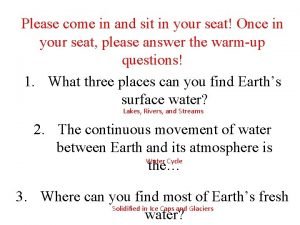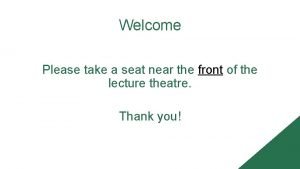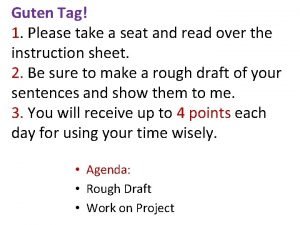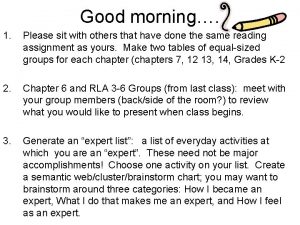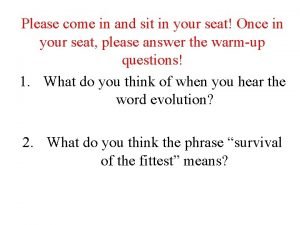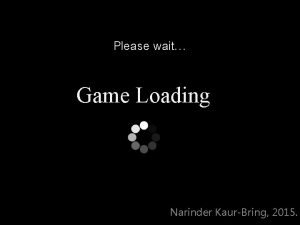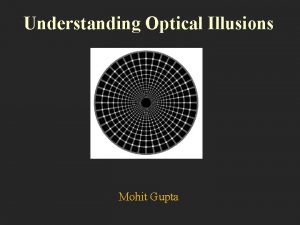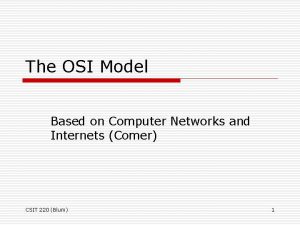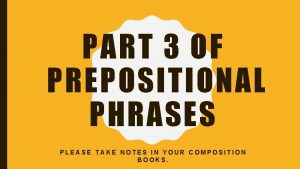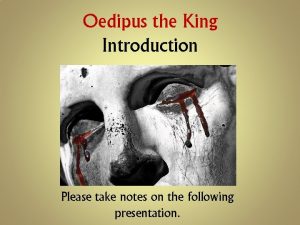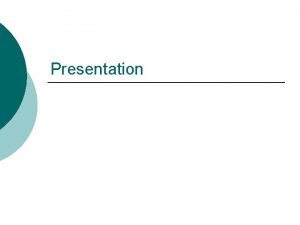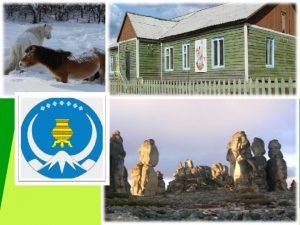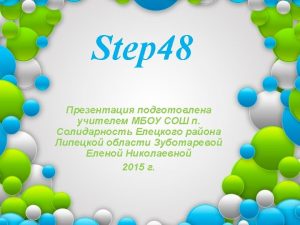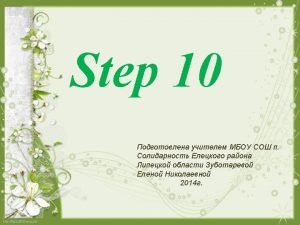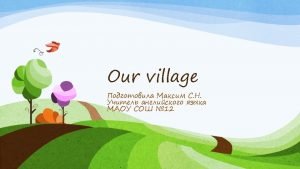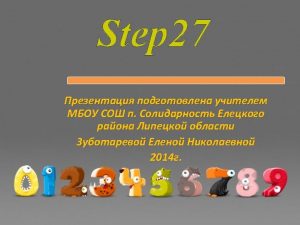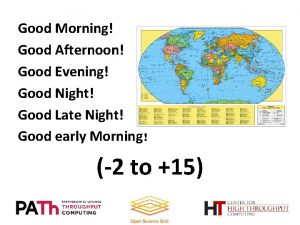GOOD MORNING Please take a seat and wait












































- Slides: 44

GOOD MORNING Please take a seat and wait for further instruction. 1

CHAPTER 15: India & the Indian Ocean Basin n Reading’s Focus q q n Islamic & Hindu Kingdoms Production & Trade in the Indian Ocean Basin (IOB) The Meeting of Hindu & Islamic Traditions The Influence of Indian Society in SE Asia Our Focus: Production & Trade in the IOB q q Specifics: Geographic, Economic, Social & Cultural “Southernization” 2

3

*NOTE Because we are focusing on the overarching topic of “Southernization”, we will not be taking notes today. Notes for this chapter can be accessed online. 4

“Southernization” Activity Complete the following tasks in preparation for our class debate and discussion at the beginning of the period tomorrow. 1. Read “Southernization” Article 2. Create Afro-Eurasia Mental Map § § Geographic Regions Movement of Goods, Ideas, People 3. Complete Questions to Consider Worksheet Any parts of this assignment unfinished by the end of the period are to be completed for homework. If you do happen to finish the assignments above, you have plenty of other assignments to keep you occupied. 5

6

Chapter 15 India and the Indian Ocean Basin 7

India After the Fall of the Gupta Dynasty n n n Invasion of White Huns from central Asia beginning 451 C. E. Gupta state collapsed mid-sixth century Chaos in northern India q q Local power struggles Invasions of Turkish nomads, absorbed into Indian society 8

King Harsha (r. 606 -648 C. E. ) n n Temporary restoration of unified rule in north India Religiously tolerant q n n Generous support for poor Patron of the arts q n Buddhist by faith Wrote three plays Assassinated, no successor able to retain control 9

Introduction of Islam to Northern India n n n Arabs conquer Sind (northwest India), 711 C. E. Sind stood at the fringe of the Islamic world Heterodox population, but held by Abbasid dynasty to 1258 C. E. 10

Merchants and Islam n n n Arabic trade with India predates Islam Dominated trade between India and the west to fifteenth century Established local communities in India q Port city of Cambay 11

Mahmud of Ghazni n n n Leader of the Turks in Afghanistan Raids into India, 1001 -1027 Plunders, destroys Hindu and Buddhist temples q Often builds mosques atop ruins 12

The Sultanate of Delhi n n Consolidation of Mahmud’s raiding territory Capital: Delhi Ruled northern India 1206 -1526 Weak administrative structure q n Reliance on cooperation of Hindu kings Nineteen out of thirty-five sultans assassinated 13

Hindu Kingdoms of Southern India n Chola kingdom, 850 -1267 C. E. q q n Maritime power Not highly centralized Kingdom of Vijayanagar q q q Mid-fourteenth century to 1565 Northern Deccan Originally supported by sultanate of Delhi Leaders renounce Islam in 1336 Yet maintain relations with sultanate 14

Major States of Postclassical India, 600 -1600 C. E. 15

Agriculture in the Monsoon World n n n Spring/summer: rains, wind from southwest Fall/winter: dry season, wind from northeast Seasonal irrigation crucial to avoid drought, famine q n Especially southern India Massive construction of reservoirs, canals, tunnels 16

The Trading World of the Indian Ocean Basin, 600 -1600 C. E. 17

Population Growth in India 18

Trade and Economic Development in Southern India n n Indian regional economies largely self-sufficient Certain products traded throughout subcontinent q n Iron, copper, salt, pepper Southern India profits from political instability in north 19

Temples and Indian Society n n More than religious centers Center of coordination of irrigation, other agricultural work q n n Some temples had large landholdings Education providers Banking services 20

Cross-Cultural Trade in the Indian Ocean Basin n n Trade increases in postclassical period Larger ships q n n Improved organization of agricultural efforts Establishment of emporia q n Dhows, junks Cosmopolitan port cities serve as warehouses for trade Specialized products developed (cotton, highcarbon steel) 21

The Kingdom of Axum n n Example of trade-driven development Founded in the highlands of northern Ethiopia about first century C. E. q n Adopted Christianity Displaces Kush as Egyptian link to the south q q Axum destroys Kushan capital Meroë ca. 360 C. E. Major territorial expansion to late sixth century 22

Obelisk at Axum 23

Challenges to Caste and Society n n Migrations Growth of Islam Urbanization Economic development q q n n Development of jati (subcastes) Similar to workers’ guilds Caste system expands from north to south Promoted by temples, educational system 24

Decline of Buddhism n n Buddhism displaced as Turkish invasions destroy holy sites, temples 1196, Muslim forces destroy library of Nalanda q Thousands of monks exiled 25

Development of Hinduism n Growth of devotional cults q n n Especially Vishnu, Shiva Promise of salvation Especially popular in southern India, spreads to north 26

Devotional Philosophers n Shankara, brahmin philosopher of ninth century C. E. q q q n Devotee of Shiva Synthesized Hindu writings in Platonic form Preferred rigorous logical analysis to emotional devotion Ramanuja, brahmin philosopher eleventh to early twelfth century q q Challenges Shankara’s emphasis on logic Laid philosophical foundations of contemporary Hinduism 27

Conversion to Islam n n Twenty-five million converts by 1500 (quarter of total population) Possibilities of social advancement for lower-caste Hindus q Rarely achieved: whole castes or jati convert, social status remains consistent 28

Sufis n n n Personal, emotional, devotional approaches to Islam Important missionaries of Islam to India Some flexibility regarding local customs 29

The Bhakti Movement n n n Attempt to bring Hinduism and Islam closer together Twelfth-century southern Hindu movement, spread to north Guru Kabir (1440 -1518) q q Taught that Shiva, Vishnu, Allah all manifestations of one deity Largely unsuccessful 30

Indian Influence in Southeast Asia n n Influence dates from 500 B. C. E. Evidence of Indian ideas and traditions q q q n Kingship Religions (Hinduism, Buddhism) Literature Caste system not as influential 31

Early States of Southeast Asia n Funan q n Kingdom of Srivijaya q n Lower Mekong River, first to sixth century C. E. Centered in Sumatra, 670 -1025 C. E. Kingdom of Angkor q q Cambodia, 889 -1431 C. E. Magnificent religious city complexes 32

Early States of Southeast Asia: Funan and Srivijaya, 100 -1025 C. E. 33

Later States of Southeast Asia: Angkor, Singosari, and Majapahit, 889 -1520 C. E. 34

Islam in Southeast Asia n n n Early populations of Muslim traders Increasing popularity with Sufi activity Many convert, retain some Hindu or Buddhist traditions 35

State of Melaka n n n Founded late fourteenth century C. E. by rebellious prince of Sumatra Dominated maritime trade routes Mid-fifteenth century converts to Islam 36

GOOD MORNING Please get out your “Southernization” materials and wait for further instruction. 37

“Southernization” Activity Recap Yesterday, you were instructed to complete the following tasks in preparation for a class discussion and debate of Shaffer’s “Southernization” Concept. 1. Read “Southernization” Article 2. Create Afro-Eurasia Mental Map § Geographic Regions § Movement of Goods, Ideas, People 3. Complete Questions to Consider Worksheet 38

“Southernization” Fishbowl • • The desks will be arranged into two circles, one within the other. Students will then be broken into two separate groups that will discuss designated questions for ten minutes. • • • Group One: Odd-Numbered Questions Group Two: Even-Numbered Questions Both: Question Nine; Additional Trading Region? While in the “fishbowl”, you must make two contributions to the discussion for credit. When you are not in the “fishbowl”, you are to be taking additional notes on the back of your handout. 39

Indian Ocean Trade: Thesis-Writing Activity What is a good thesis? 40

What is a good thesis? Students struggle with this idea constantly, whether writing a change-over-time essay, document-based piece, or comparison essay. The opportunity to create a road map, showing what will be proven with evidence throughout an essay, is daunting, but if students use the correct tools, the task is manageable and the students will be successful. Good thesis writing begins with looking critically at the question and determining groups that will answer the question. Students need to be able to organize their essays through that short statement, setting them up for how they will organize their entire essay. Indian Ocean trade changed over time; this statement does not tell the reader what caused that change, where change was seen, or what outside forces facilitated this change. Our students need to create better maps in writing their essays using specific information and historical facts. 41

Indian Ocean Trade: Thesis-Writing Activity Why will this thesis statement not work? Indian Ocean trade changed over time from 500 BCE to 1400 CE. 42

Indian Ocean Trade: Thesis-Writing Activity Within your pod, complete the following tasks. Using the tables provided, create distinct categories of analysis, focusing on why trade within the Indian Ocean changed over time. 2. Examine and familiarize yourselves with the outline of an “imaginary” essay, which provides the intended topic sentences and evidence. 3. Create a better thesis using your categories of analysis as well as the outline provided. 4. Write your new and improved thesis statement on the white board at the front of the room and be prepared to discuss. 1. 43

Comparative Essays n Colors: q q n Blue: Suggestions for Improvement Pink: Graded Aspects Comparative Grading Rubric q q q Thesis Statements: Varied All Parts of Question: Generally Successful Evidence: Varied Direct Comparisons: Generally Successful Analysis: Barely Attempted Expanded Core: Not Quite *If you would like to discuss your essay, you may approach me only when 24 hours has elapsed from the time of distribution. 44
 Good morning please have a seat
Good morning please have a seat Good evening have a seat
Good evening have a seat Good evening have a seat
Good evening have a seat Good morning please have a seat
Good morning please have a seat Good afternoon students
Good afternoon students Please come in and take a seat
Please come in and take a seat Welcome please take a seat
Welcome please take a seat Please take a seat
Please take a seat Good morning class images
Good morning class images Good afternoon teacher.
Good afternoon teacher. Good morning welcome to class
Good morning welcome to class Hello friend! i am glad to see you!
Hello friend! i am glad to see you! Good afternoon please have a seat
Good afternoon please have a seat Hi, good evening
Hi, good evening Buenas tardes good afternoon
Buenas tardes good afternoon Mr unimportant good morning
Mr unimportant good morning Simplissimus 3 june 1919
Simplissimus 3 june 1919 Good morning please
Good morning please Sit in your seat
Sit in your seat Please sit down and your seat belts
Please sit down and your seat belts Greetings responses
Greetings responses Please wait the webinar will begin soon
Please wait the webinar will begin soon Loading please wait artinya
Loading please wait artinya Loading please wait artinya
Loading please wait artinya Game loading please wait
Game loading please wait Good morning ladies and gentlemen speech
Good morning ladies and gentlemen speech Good morning revival
Good morning revival Good morning good lookin
Good morning good lookin Good morning students,
Good morning students, Good evening ladies and gentlemen
Good evening ladies and gentlemen Nobody said anything raymond carver
Nobody said anything raymond carver Adelson's checkerboard
Adelson's checkerboard Good thoughts good deeds good actions
Good thoughts good deeds good actions Nothing compares to your embrace
Nothing compares to your embrace Slam poetry rubric
Slam poetry rubric Don't throw sausage pizza away
Don't throw sausage pizza away Please take notes
Please take notes Please take out some time
Please take out some time Oedipus notes
Oedipus notes Take a bus or take a train
Take a bus or take a train No one loves me
No one loves me Are you sleeping brother john drawing
Are you sleeping brother john drawing Good morning welcome back
Good morning welcome back Aslamualaikum morning wish
Aslamualaikum morning wish Good morning distinguished guests
Good morning distinguished guests





